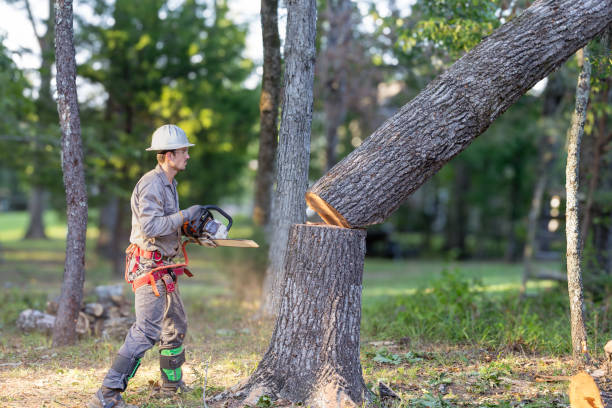Safety can’t be overstated when you’re considering tree removal.
It’s not just about grabbing a chainsaw and going to work; there’s much more to it.
Have you considered the protective gear you’ll need or the potential hazards lurking above?
Evaluating the tree’s condition and surroundings is crucial before making the first cut.
And let’s not forget about the escape route—do you have one planned?
These are just a few important considerations to ponder as you prepare for the task.
What steps will you take to ensure a successful and safe project?
(h2) Essential Tools and Gear
Gearing up with the right tools and safety gear is vital for a successful and safe DIY tree removal.
Here’s what you’ll need:
(h3) Tools:
- Chainsaw: Choose a lightweight yet powerful model that fits the size of the tree. Ensure it’s well-maintained and has sharp blades for smooth, precise cuts.
- Ladder: A sturdy extension ladder is crucial for safely reaching higher branches and maintaining stability.
- Loppers or Pruning Shears are great for trimming smaller branches before tackling the larger ones.
(h3) Safety Gear:
- Hard Hat: Protects your head from falling branches and debris.
- Safety Goggles: Shields your eyes from flying sawdust, wood chips, and debris.
- Ear Protection: Chainsaws are loud, so earplugs or earmuffs are essential for hearing protection.
- Durable Gloves: Provides grip and protect your hands from cuts, splinters, and blisters.
- Steel-toed boots offer good traction and protect your feet from falling branches or tools.
(h3) Additional Gear:
- Ropes or Tree harnesses help you secure yourself or heavy branches to maintain control and prevent unexpected falls or mishaps.
- Wedges or Falling Bars guide the tree’s fall direction and prevent the saw from getting stuck.
By preparing with the right tools and safety gear, you’ll be set for a more efficient and secure tree removal process.
(h2) Identifying Potential Hazards for DIY Tree Removal
Before starting any DIY tree removal, it’s important to identify hazards that could put you at risk.
(h3) Tree Assessment
- Weak or Dead Branches: Check for branches that may fall unexpectedly.
- Disease or Decay: Look for signs of rot or illness that could weaken the tree.
- Power Lines: Contact a professional if the tree is near or tangled with power lines.
(h3) Surrounding Environment
- Obstacles: Be mindful of buildings, fences, or other trees that may be in the way.
- Uneven Terrain: Hidden roots or uneven ground can cause trips or loss of balance.
- Wildlife: Watch for nests or beehives that could be disturbed.
(h3) Weather Conditions
- Avoid Bad Weather: Strong winds or rain make the job more dangerous. Wait for clear, calm weather.
(h3) Safety Gear
- Personal Protection: Wear gloves, helmets, and goggles to shield yourself from potential debris and accidents.
By carefully assessing these potential hazards, you can minimise risks and ensure a safer, smoother tree removal process. Safety always comes first!
(h2) Proper Cutting Techniques for Safe Tree Removal
Mastering proper cutting techniques is crucial for a safe and efficient tree removal process.
(h3) Notch Cut
- Make the Notch Cut
Start by creating a notch cut on the side of the tree facing the desired fall direction. The cut should be about one-third of the tree’s diameter, angled at 70 degrees.
- Purpose of the Notch
This cut guides the tree’s fall, so precision is essential to control its descent.
(h3) Back Cut
- Position the Back Cut
Move to the opposite side of the notch and make a back cut slightly above the bottom of your notch. This forms a hinge, which controls the tree’s movement.
- Avoid Cutting Through the Hinge
Leave the hinge intact to guide the tree safely to the ground. Cutting through it can result in unpredictable movement.
(h3) Safety Awareness
- Plan Your Escape Route: Always have a clear exit path before the tree falls. Once it begins to move, retreat to a safe distance while keeping an eye on the tree’s direction.
- Stay Alert: Never turn your back on a falling tree—watch its path until it’s fully grounded.
By following these cutting techniques, you can ensure your safety and that of nearby property during tree removal.
DIY tree removal is a serious undertaking that requires preparation, the right tools, and a thorough understanding of safety procedures.
You can ensure a smoother, safer project by equipping yourself with proper gear, identifying hazards, and using precise cutting techniques.
Remember, tree removal can be dangerous—when in doubt, don’t hesitate to consult a professional for assistance.
Prioritise safety to protect yourself, your property, and those around you.

